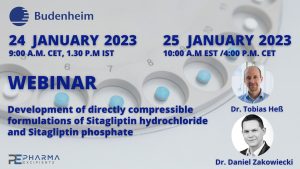Drop-on-powder 3D printing of amorphous high dose oral dosage forms: Process development, opportunities and printing limitations

Drop-on-powder 3D printing is able to produce highly drug loaded solid oral dosage forms. However, this technique is mainly limited to well soluble drugs. The majority of pipeline compounds is poorly soluble, though, and requires solubility enhancement, e.g., via formation of amorphous solid dispersions. This study presents a detailed and systematic development approach for the production of tablets containing high amounts of a poorly soluble, amorphized drug via drop-on-powder 3D printing (also known as binder jetting).
Highlights
- Novel approach to produce high dose amorphous tablets containing a poorly soluble drug by drop-on-powder printing.
- Assessment of ideal printing parameters using a time-efficient small-scale screening.
- Manufacturing of amorphous tablets via drop-on-powder printing with good mechanical properties and physical stability.
Amorphization of the compound was achieved via hot-melt extrusion using the exemplary system of the model compound ketoconazole and copovidone as matrix polymer at drug loadings of 20% and 40%. The milled extrudate was used as powder for printing and the influence of inks and different ink-to-powder ratios on recrystallization of ketoconazole was investigated in a material-saving small-scale screening. Crystallinity assessment was performed using differential scanning calorimetry and polarized light microscopy to identify even small traces of crystallinity. Printing of tablets showed that the performed small-scale screening was capable to identify printing parameters for the development of amorphous and mechanically stable tablets via drop-on-powder printing. A stability study demonstrated physically stable tablets over twelve weeks at accelerated storage conditions.
2.1. Materials
KTZ was purchased from LGM Pharma (Boca Raton, USA). Copovidone (Kollidon® VA64, Vinylpyrrolidone-vinyl acetate copolymer) was purchased from BASF (Ludwigshafen, Germany). Methylene blue and the solvents ethanol, methanol and isopropyl alcohol (purity ≥99.9%) were provided by Merck (Darmstadt, Germany). Colloidal silicon dioxide was purchased from Evonik Industries (Essen, Germany).
Download the full study as PDF here: Drop-on-powder 3D printing of amorphous high dose oral dosage forms: Process development, opportunities and printing limitations
or read it here
Nadine Gottschalk, Alicia Burkard, Julian Quodbach, Malte Bogdahn, Drop-on-powder 3D printing of amorphous high dose oral dosage forms: Process development, opportunities and printing limitations, International Journal of Pharmaceutics: X, Volume 5, 2023, 100151, ISSN 2590-1567,
https://doi.org/10.1016/j.ijpx.2022.100151.
Our next webinar:
For free registration and more information click on the picture below or here:


